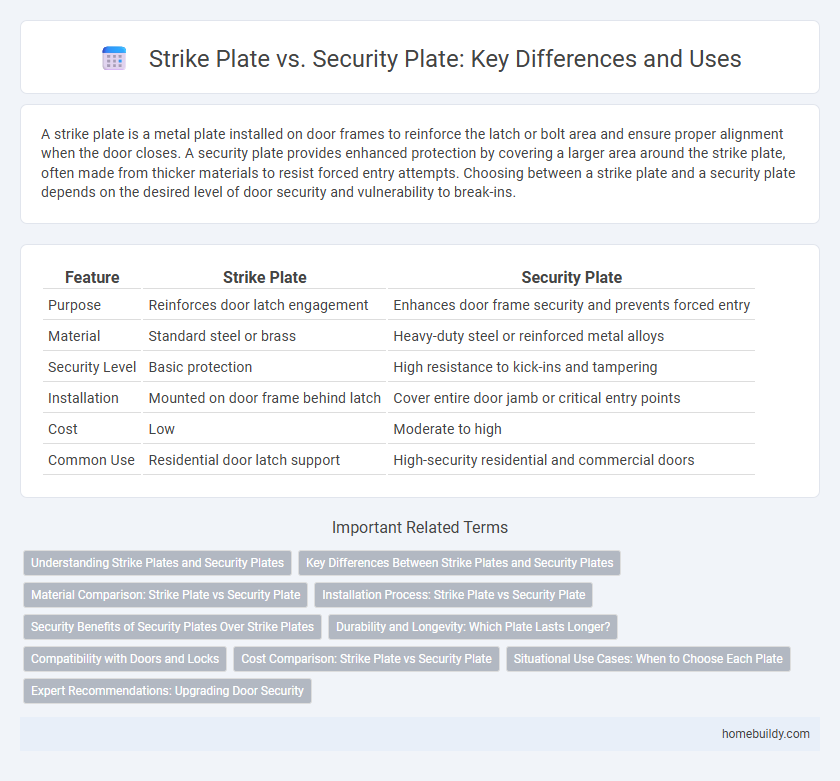A strike plate is a metal plate installed on door frames to reinforce the latch or bolt area and ensure proper alignment when the door closes. A security plate provides enhanced protection by covering a larger area around the strike plate, often made from thicker materials to resist forced entry attempts. Choosing between a strike plate and a security plate depends on the desired level of door security and vulnerability to break-ins.
Table of Comparison
| Feature | Strike Plate | Security Plate |
|---|---|---|
| Purpose | Reinforces door latch engagement | Enhances door frame security and prevents forced entry |
| Material | Standard steel or brass | Heavy-duty steel or reinforced metal alloys |
| Security Level | Basic protection | High resistance to kick-ins and tampering |
| Installation | Mounted on door frame behind latch | Cover entire door jamb or critical entry points |
| Cost | Low | Moderate to high |
| Common Use | Residential door latch support | High-security residential and commercial doors |
Understanding Strike Plates and Security Plates
Strike plates reinforce door frames by providing a solid metal surface for the latch or bolt to engage, enhancing the door's structural integrity. Security plates are heavy-duty versions of strike plates designed to resist forced entry by distributing impact force and covering vulnerable areas around the lock. Understanding the differences between standard strike plates and security plates is essential for improving door security and preventing break-ins.
Key Differences Between Strike Plates and Security Plates
Strike plates are metal components installed on door frames that reinforce the area where the latch or bolt engages, primarily focusing on providing a secure point for locking mechanisms. Security plates enhance this function by offering thicker, more durable materials and extended coverage areas to resist kick-in attacks and provide higher protection against forced entry. The key differences lie in their material strength, coverage size, and resistance capabilities, with security plates designed to improve overall door security beyond the basic strike plate's function.
Material Comparison: Strike Plate vs Security Plate
Strike plates are typically made from stainless steel or reinforced zinc, providing durability and basic protection against door forced entry. Security plates, however, use hardened steel or reinforced alloys designed to withstand higher impact forces and resist tampering or drilling attempts. The superior material strength of security plates significantly enhances door reinforcement compared to standard strike plates.
Installation Process: Strike Plate vs Security Plate
Installing a strike plate involves simple alignment and securing it to the door frame with screws, ensuring the latch or bolt fits properly for basic door functionality. In contrast, installing a security plate requires additional reinforcement steps, including embedding the plate deeper into the frame, using longer screws to anchor into wall studs, and sometimes reinforcing the surrounding area to enhance resistance against forced entry. The security plate installation demands more precision and structural modifications to maximize door security compared to the straightforward setup of a standard strike plate.
Security Benefits of Security Plates Over Strike Plates
Security plates provide enhanced protection by reinforcing door frames and preventing forced entry more effectively than standard strike plates. They are constructed from heavy-duty materials and cover a larger surface area, distributing impact forces to reduce frame damage during break-in attempts. Installing security plates significantly increases resistance to kick-ins and prying attacks, improving overall door security.
Durability and Longevity: Which Plate Lasts Longer?
Strike plates are typically made from steel or brass, offering solid durability but often thinner than security plates designed specifically for enhanced protection. Security plates are constructed with reinforced materials like heavy-gauge steel, significantly increasing their resistance to impact and wear, resulting in longer-lasting performance. When prioritizing longevity and durability, security plates generally outperform standard strike plates due to their robust design and superior material strength.
Compatibility with Doors and Locks
Strike plates are specifically designed to fit standard door frames and align precisely with common lock types such as deadbolts and latch bolts, ensuring smooth operation and security. Security plates, however, are often reinforced with heavier materials and extended dimensions to provide enhanced protection, which might require door modifications or compatibility checks before installation. Choosing between strike plates and security plates depends on the door material, lock type, and the required level of security without compromising fit or functionality.
Cost Comparison: Strike Plate vs Security Plate
Strike plates generally come at a lower cost compared to security plates, making them a budget-friendly option for basic door reinforcement. Security plates, designed with reinforced materials such as steel alloys, can cost two to three times more but offer significantly enhanced protection against forced entry. Investing in a security plate can reduce long-term expenses related to break-ins by providing superior durability and resistance.
Situational Use Cases: When to Choose Each Plate
Strike plates are essential for reinforcing door frames at the latch or deadbolt point, typically used in residential settings for standard security and door alignment. Security plates offer enhanced protection by covering a larger area around the strike plate, ideal for high-risk environments such as commercial buildings or homes in areas with higher break-in rates. Choosing between a strike plate and a security plate depends on the level of security needed and the specific vulnerability of the door frame in its situational context.
Expert Recommendations: Upgrading Door Security
Experts recommend upgrading from a standard strike plate to a reinforced security plate to significantly enhance door security by resisting forced entry attempts. Security plates are made from hardened steel and often feature extended screws that anchor deeper into the door frame, providing improved protection against kick-ins. This upgrade is a cost-effective solution endorsed by locksmith professionals to bolster home and commercial door defenses.
Strike plate vs security plate Infographic

 homebuildy.com
homebuildy.com